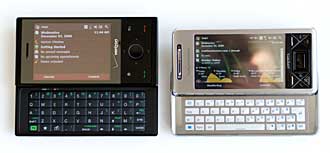
|
||||||||
AT&T loads the Fuze with more software and branding than does Sprint on the Touch Pro. At times we felt like the Fuze contained a minefield of subscription services-- accidentally press that annoying PTT button and you're asked if you'd like to purchase the $10/month service (make sure to hit the little "no" button!). Want to play one of the many pre-installed, non-removable games for more than 90 seconds? You must buy it. Likewise there are quite a few apps on the phone that are tempting but lead to more monthly fees (XM Radio, Music ID, MobiTV and more). There are myriad application and game demos (approx. 15!) and that's way too much crapware for a phone. To house some of this sales and subscription-ware, AT&T has added a new tab to TouchFLO 3D for a selection of their applications. There are icons for AT&T Music related apps (online music store backed by Napster and a variety of subscription-based services like XM Radio and MusicID), CV (AT&T's streaming video service), AT&T Navigator, Push to Talk, Media Net (AT&T's portal page), games (there are a slew of demo games installed on the device), AT&T Mall (yep, more software shopping for your brand new phone), messaging applications (the standard Windows Mobile SMS/MMS and email clients along with a link to get AT&T's Xpress Mail and OZ' very good IM client for AIM, MSN Messenger and Yahoo. There's also a link in the messaging group to get BlackBerry Connect software from HTC's web site but as of this writing, that app isn't ready yet. An icon for the "Tools" folder is mysteriously nestled in the AT&T tab too. These are standard HTC and Windows Mobile apps in most cases, and not AT&T products or services.
Strangely, AT&T hid HTC's YouTube player icon, which is present on every other TouchFLO 3D HTC model. But don't despair: it's still there. Use the built-in File Explorer to visit the Windows directory and scroll down until you find the YouTube application. You can copy this and paste a shortcut in the Windows Start Menu or wherever you like for easier access. It works just fine over HSDPA and WiFi. Also strange is AT&T's choice for a theme color. The Diamond and Touch Pro family of devices are sleek and black and come with matching black themes that look great on the phone. AT&T went with gray... yep. And that's the only TouchFLO 3D theme on the device so no hope of changing it unless you're willing to play with 3rd party UI hacks or registry edits. The final hardware differences are chrome trim around the sides of the Sprint version (AT&T went with the more common black sides and these are metal) and a big Push to Talk button midway down the left hand side. This is the only button that protrudes from the device and it's easy to accidentally press it. Unfortunately, there's no way to change the button to either do nothing or launch something like the camera (there is no dedicated camera button, instead you access it through the Camera tab on TouchFLO 3D) using the Windows Mobile Buttons applet. Instead, for those more technically included, you can install a registry editor (yep, WinMo has a registry just like Windows) and edit the button mapping.
The volume buttons and PTT button. To see and learn more about the Fuze, and to see it side-by-side with the Sprint version, view our video review below. It covers AT&T's customization of TouchFLO 3D, the browser, the hidden YouTube player, GPS and more:
Performance and Horsepower The Fuze has good performance for a phone that's running TouchFLO 3D and we found it more responsive than the earlier GSM Diamond and Pro models, though not as quick as the Sprint Diamond and Touch Pro. There are occasional slow downs if many applications are left running. By default, Windows Mobile doesn't exit programs when you hit the x box up to, it merely minimizes them, so it's easy to have an army of apps marching in the background. HTC includes a home screen applet on the upper right corner that will show you currently running applications and allow you to exit them before things get out of hand.
Size comparison: the HTC Touch Pro (Verizon variant of the Fuze) and the Sony Ericsson Xperia X1a. The Fuze, like all Raphael and Diamond models, runs on a 528MHz Qualcomm processor with 512 megs of flash memory for storage. Of that 512 megs, approximately 270 megs are free for your use after AT&T's customizations and AT&T Navigator have been installed. The smartphone has an SDHC microSD card slot under the back cover (thankfully, there's no need to pull the battery to swap a card). The Fuze has a capacious 288 megs of RAM to run programs, and both TouchFLO 3D and the Opera web browser need some serious memory.
The T-Mobile G1 (made by HTC) and the HTC Fuze. The Fuze handles video playback well using Windows Media Player Mobile for locally stored content and HTC's streaming media player for online content. YouTube playback occasionally stalls and crawls over 3G, but overall is sharp-looking and pleasant. CV content is low quality stuff, all the more noticable when it's stretched to VGA, but we're happy that HTC's streaming media player handles playback rather than Windows Media Player Mobile as on other Windows Mobile AT&T phones. Phone and Data The HTC Fuze is a quad band GSM world phone that works anywhere GSM service is available. It has 3G HSDPA on the US AT&T bands (850/1900MHz) as well as the 2100MHz band for Europe and parts of Asia. Phone voice quality is good and volume is average compared to other AT&T phones (a little too low for a noisy mall but fine for less cacophonous places). There's no incoming audio distortion or buzzing, though we did hear a little echo on our end. The Fuze played nicely with a variety of Bluetooth headsets including the Plantronics Discovery 925, Jawbone and Samsung WEP200. It also works with stereo Bluetooth headsets over A2DP with AVRC, and audio quality for music is excellent. Like all Windows Mobile phones, the Fuze supports call waiting, conference dialing, speed dialing and smart dialing. HTC and AT&T include Microsoft Voice Command 1.6, a very good speaker voice command and dialing application that requires no voice tag recording. Voice Command can handle dialing commands such as "call Jane Doe mobile" and "when is my next appointment". We found the Fuze a little hard of hearing compared to the Sprint Touch Pro and Samsung Epix running voice command, and occasionally had to repeat a command. That said, it heard us and heard us correctly at that, on the second try. To activate voice command, press and hold the call send button. Reception on 3G is good, and is slightly better than the Tilt (as measured in -db using Field Test, not going by the signal bars). The antenna is at the bottom of the phone, so if you notice your reception dropping when holding the phone for a call, try holding it by the sides or nearer to the top.
Data transfer speeds were impressive according to DSL Reports' mobile speed test. The Fuze averaged 1,100kbps while our Epix averaged 650kbps. Web page download speeds are quite good with the included Opera 9.5 web browser and Internet Explorer Mobile. As always, Opera 9.5 impresses us, and we found it runs more smoothly and quickly on the US carrier versions compared to the import GSM Diamond and Touch Pro. It handles full HTML sides admirably, and supports finger scrolling that's almost as smooth as the iPhone's. For email there's the usual strong suite of WinMo supported accounts: POP3, IMAP, MS Exchange and Direct Push email. As we mentioned, there's a link to download BlackBerry Connect which we expect to be live soon. The Fuze can send and receive SMS text message and MMS messages as well. GPS The HTC Fuze has an internal GPS with aGPS (location positions are aided by cell tower triangulation). The phone has HTC's usual QuickGPS which downloads satellite data weekly to speed positioning, and there's an aGPS applet that turns on/off aGPS (we can't think of a reason to turn this off since it really speeds up location fixes and doesn't use data). The PDA phone comes with an icon that leads you to the full download of AT&T Navigator, formerly named TeleNav. Even if you don't intend to use TeleNav, download and run it once (it will run in free trial mode for 3 days). This sets up the GPS for use and is your path to success for using other GPS programs such as Google Maps, Garmin XT Mobile or other navigation applications.
For those who are interested in AT&T Navigator, it's an excellent mapping and navigation application with spoken turn-by-turn directions. TeleNav's maps are accurate, routing is logical and expedient and maps download quickly over 3G and decently fast over EDGE. Navigator does require a data plan since maps and POIs are downloaded over the data connection, and the service itself costs $9.99/month or $99/year. While some folks hate paying monthly fees, the good part is that TeleNav is constantly updating their map and routing data, so it's always up to date. Likewise you need not use a PC sync or special microSD card to have the maps you need. Of course, if you travel to the far reaches of never-never-land where even GSM and EDGE aren't available, Navigator won't work. The Fuze, like the GSM Diamond, isn't the best at getting a cold fix (in layman's terms, that means finding your location after the phone has been rebooted). Most phones with aGPS can get a fix in less than 30 seconds indoors near a window these days, but the Fuze had to be outdoors and then it took more than a minute to get a 3D fix. Subsequent warm starts were much faster (10 seconds), so this is an issue only after rebooting the phone. Once it found itself in the world, the GPS managed to keep up with us when driving, and didn't experience much lag.
Battery Life The Fuze is a powerful phone with a large, bright VGA display, 3G, CV and YouTube to drain lots of power and a fast CPU. That's our way of saying that the battery life isn't great. It's certainly no worse than the Sprint version, and in fact it's just a bit better. But if you're a heavy user in terms of push email, calls, multimedia the Fuze will need to visit the charger every night when you get home. Or get a second charger and juice it up while at work. the Fuze's 1340 mAh battery is user replaceable, so you could pick up a spare battery if you're a heavy phone user who's not near a charger during the day. With light use, the Fuze lasts two days, and with moderate use, 1.5 days. Conclusion Some of us have been waiting months for this phone to hit the US, and it's a formidable successor to the HTC Tilt. In terms of looks and size, it's a flat out winner. Though thicker than QWERTY bar phones, its relatively small width and height mean it does feel overly large. The Fuze is feature-packed and call quality is good. But AT&T's heavy-handed branding, complete with a host of non-removable demo and subscription-ware make the phone seem less clean and responsive than the Sprint version. We'd like to sit down for a serious talk with the person who designed that annoying PTT button-- even if we intended to use that service, we wouldn't want to accidentally launch it nearly every time we handle the phone. On the upside, the Fuze has a superb VGA display, the second best web browser after the iPhone's Safari, and can handle all manner of syncing and email. Pro: Wonderful display, TouchFLO 3D does a good job of making WinMo more fun, attractive and easy to use. Good multimedia support, the usual excellent WinMo business-oriented features (Exchange, push email, syncing with desktops or Exchange over the air), good keyboard (though we want the number row) and very attractive design. Con: GPS cold starts are mind-numbingly slow. Way too much bloatware. That AT&T gray theme is drab. Streaming video on YouTube sometimes proves too taxing for the phone (is this why AT&T removed the icon, or was that simply a bandwidth reduction measure?). Battery life is so-so if you consume lots of data and multimedia.
Price: $349 ($299 after $50 data plan rebate) with 2 year contract. $499 without contract. Web sites: wireless.att.com, www.htc.com
| ||||||||













